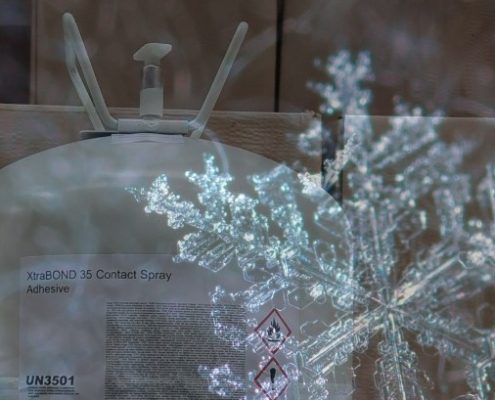
Cold Weather: winter adhesive storage & usage
Much of the UK enjoyed some fun in the winter snow in recent days, and many gardens now play host to visiting snowmen! With areas of the UK experiencing temperatures in the minus figures, manufacturers utilising adhesives within their processes should be aware that this can have an effect on both the shelf life and performance of many adhesive products.
In general, storage between 5°C & 25°C is recommended to ensure the maintained quality of your adhesives, specific temperature guidelines for individual products can be located within the product’s technical data sheet. Below we provide information and advice for keeping your adhesives running at peak performance during the cold winter months.
SPRAY ADHESIVES
When the temperature of a spray adhesive canister drops due to cold storage temperatures, the adhesive contents within will thicken and impact on the product’s performance quality. The compressed gases used within these pressurised products will shrink in cold temperatures, and this shrinking effect, combined with a potentially thickened product, means that the user is likely to find the adhesive sprays with difficulty and provides uneven distribution. Working with pressurised spray adhesives in low temperatures can therefore result in poor glue distribution, higher usage quantities, and an inconsistent bond quality.
Hybond recommend: Storing spray adhesives at temperatures no lower than 5°C, ideally off the floor where temperatures are likely to be at their lowest. Should you suspect that your spray adhesive canisters have become too cold, it is important to return them to operating temperature in a controlled and safe manner, as the compressed gases within are extremely volatile when over-heated; please contact our technical team here should you wish to obtain further advice in this area.
HOT MELT ADHESIVES
The viscosity of hot melt adhesives increases in low temperatures, and the user may find the adhesive then creates an undesirable stringing effect upon application. This may be caused by either a low application temperature, a low ambient temperature within the manufacturing facility, or a cold nozzle temperature.
Hybond recommend: increasing the nozzle head temperature, as well as the pot and hose temperature in 5-degree increments. This will lower the product viscosity, and reduce the likelihood of stringing. It is important to remember that cold air within the working environment, and also substrate temperature can have an effect on the setting speed a hot melt; please contact our technical team here should you wish to obtain further advice in this area.
WATER BASED ADHESIVES
It is generally the transportation of water-based adhesives during the colder winter months that results in potential freezing of the product whilst in transit, and this will have a negative impact on product performance and shelf life.
Hybond recommend: considering careful timing of adhesive orders to avoid the goods sitting for extended periods of time in cold vehicles or transportation depots; you may for example wish to order goods at the beginning of the week and avoid delays to delivery over the weekend. Furthermore, water-based adhesives used in cool plant conditions may thicken and result in adhesive stringing and poor machining. Setting speeds are likely to become slower in cold conditions as the water content releases more slowly within the adhesive. Applying adhesive in ambient room temperatures will help to avoid issues such as this, please contact our technical team here should you wish to obtain further advice in this area.





